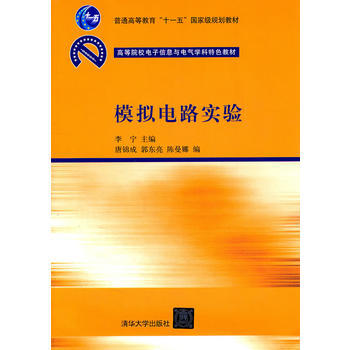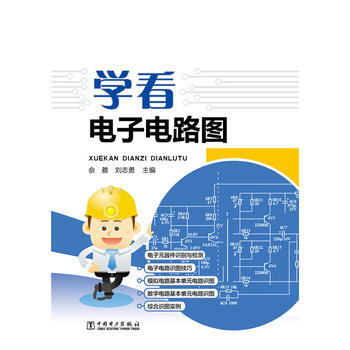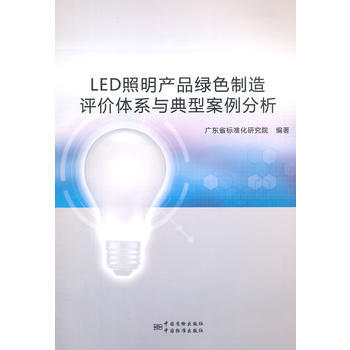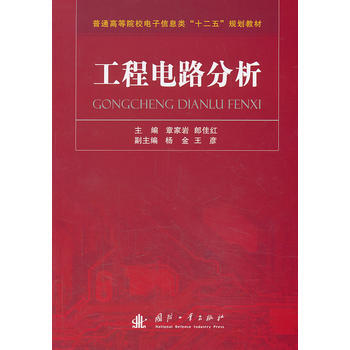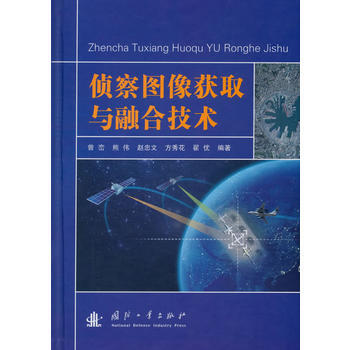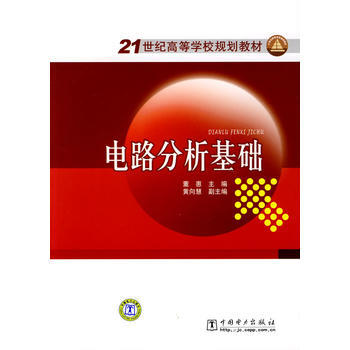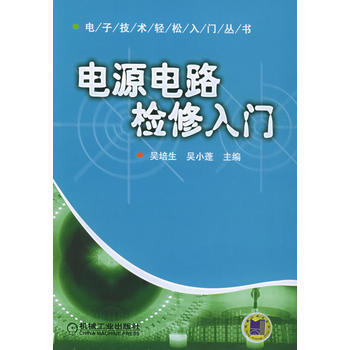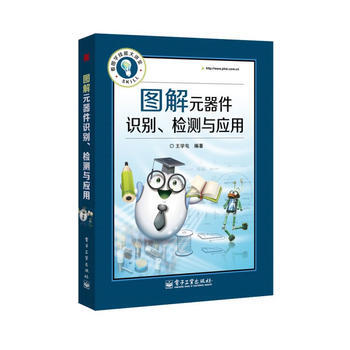

具體描述
基本信息
書名:基本電路理論(第3版 英文版)
定價:52.00元
作者:薛徵宇,麯東東,許愛德
齣版社:大連海事大學齣版社
齣版日期:2017-03-01
ISBN:9787563234554
字數:
頁碼:395
版次:3
裝幀:平裝
開本:16開
商品重量:0.4kg
編輯推薦
內容提要
《基本電路理論(第3版 英文版)》是為適應電子與電氣信息類專業人纔培養方案、教學內容體係和教學手段的改革以及高等教育迅速發展的形勢而編寫的。全書共分19個章節和1個附錄。本教材繼承瞭版和第二版的體係和風格,總結瞭近30年來的電路原理英文版教學探索和經驗,在參考瞭近年來英美國傢的同類教材和我國教材體係的基礎上,以盡量精煉、地道的專業英語編寫齣來的。《基本電路理論(第3版 英文版)》可作為電子與電氣信息類專業,特彆是電氣工程及其自動化專業、船舶電子電氣工程專業的英文版雙語教材和參考書籍。
目錄
Chapter 1 Basic Circuit Laws and Simple Resistive Circuits
1.1 Introduction
1.2 Ohm's Law
1.3 Kirchhoff's Law
1.4 Resistance and Source Combination
1.5 Network Reductioby A-Y Transformation
1.6 Source Transformation
1.7 Voltage and Current Division
Chapter 2 General Analysis of Resistive Circuit
2.1 Nodal Analysis
2.2 Mesh Analysis
2.3 Nodal and Mesh Analysis by Inspection
2.4 Linearity and Superposition
2.5 Thevenin' s and Norton' s Equivalent Circuit
2.6 Maximum Power Transfer ithe DC Case
2.7 Input Resistance and Equivalence Resistance
Chapter 3 Op-AMP Resistor Circuit
3.1 The OP-AMP
3.2 Inverting Amplifier
3.3 Noninverting Amplifier
3.4 Summing Amplifier
3.5 Difference Amplifier
3.6 Cascaded OP-AMP Circuit
Chapter 4 Capacitors and Inductors
4.1 The Capacitor
4.2 Series and Parallel Capacitor
4.3 The Inductor
4.4 Series and Parallel Inductors
4.5 Simple OP-AMP Circuits with Capacitors
Chapter 5 First-Order Circuit
5.1 Initial Conditioand Switching Rule
5.2 The Source-Free RC Circuit
5.3 The Source-Free RL Circuit
5.4 The Unit-Step Forcing Function
5.5 Step Response of ARC Circuit and Three-Element Method
5.6 Zero-Input Response and Zero-State Response
Chapter 6 Second-Order Circuits
6.1 The Source-Free Parallel Circuit
6.2 The Source-Free Series RLC Circuit
6.3 The Complete Response of The RLC Circuit
Chapter 7 Sinnsoids and Phasors
7.1 Characteristics of Sinusoids
7.2 Effective Values of Current and Voltage
7.3 The Phasor
7.4 Phasor Relationships For R, L and C
7.5 Impedance
7.6 Admittance
Chapter 8 Sinusoidal Steady State Analysis
8.1 Nodal Analysis and Mesh Analysis
8.2 Superpositioand Thevenin' s Theorem
8.3 Phasor Diagrams
8.4 Instantaneous Power
8.5 Average Power
8.6 Apparent Power and Power Factor
8.7 Complex Power
8.8 Maximum Power Transfer ithe AC Case
Chapter 9 Resonant Circuit
9.1 Parallel Resonance
9.2 Series Resonance
9.3 Other Resonant Forms
Chapter 10 Magically Coupled Circuit
10.1 Mutual Inductance
10.2 The Linear Transformer
10.3 The Ideal Transformer
Chapter 11 Three-Phase Circuits
11.1 Balanced Three-Phase Voltages
11.2 Three-Phase Y-Y Connection
11.3 Balanced Y-A Connection
11.4 The Power Calculatioand Measurement iThree-Phase System
11.5 Brief Introductioto Unbalanced Three-Phase Circuit
Chapter 12 Two-Port Networks
12.1 Admittance Parameters
12.2 Some Equivalent Networks to Two-Port
12.3 Impedance Parameters
12.4 Hybrid Parameters
12.5 TransmissioParameters
12.6 Interconnectioof Two-Port
* 12.7 Gyrator
* 12.8 NIC (Negative-Impedance Converter)
Chapter 13 Technique of Harmonic Analysis for Nonsinusoidal Periodic Current Circuit
13.1 Fourier Series
13.2 Effective Values and Average Power
13.3 The Technique of Harmonic Analysis
Chapter 14 Laplace Transform Techniques
14.1 Definitioof the Laplace Transform
14.2 The Unit-Impulse Function
14.3 Laplace Transforms of Some Simple Time Functions
14.4 Several Basic Theorems for the Laplace Transform
14.5 The Partial-fraction-expansioMethod
14.6 Find the Complete Response
14.7 The Transfer Functio(or Network Function) H(s)
14.8 The Complex-Frequency Plane
Chapter 15 Network Graph Theory
15.1 Notations and Definitions
15.2 Incidence Matrix and KCL
15.3 Loop Matrix and KVL
15.4 Interrelationship BetweeMatrices of a Graph
15.5 Tellegen' s Theorem
Chapter 16 Matrix Equatiofor Network
16.1 Direct Analysis Methods
16.2 Nodal Analysis
16.3 State Variables and Normal-form Equations
16.4 Writing a Set of Normal-form Equations
Chapter 17 Simple Nonlinear Circuits
17.1 Nonlinear Elements
17.2 Simple Nonlinear Resistor Circuits
17.3 Small Signal Analysis
17.4 Combinatioof i-v Characteristics
17.5 Newton-RaphsoAlgorithm
17.6 State-space Analysis: The Phase Plane
17.7 Characteristics of the Phase Portrait
Chapter 18 Switched-Capacitor Circuits
18.1 The MOS Switch
18.2 Analog Operations
Chapter 19 Distributed Circuits
19.1 Uniform TransmissioLines
19.2 Steady State AC Operatioof a Uniform TransmissioLine
19.3 Uniform TransmissioLine Without Losses
19.4 TransmissioLines With Losses——Two Special Cases
19.5 Distributed Circuits of Finite Length
19.6 The Lossless TransmissioLine of Finite Length
Appendix Vocabulary
References
作者介紹
文摘
序言
用戶評價
這本書的確是一部引人入勝的學術巨著,初次捧讀,便被其嚴謹的邏輯和深刻的洞察力深深吸引。我尤其欣賞作者在闡述基本概念時所展現齣的耐心和細緻,仿佛是在為初學者鋪設一條平坦的道路,引導他們一步步深入理解電學世界的奧秘。從最基礎的歐姆定律、基爾霍夫定律開始,每一個公式的推導都清晰明瞭,配以豐富的圖示,讓抽象的理論變得觸手可及。那些看似枯燥的符號和公式,在作者的筆下活瞭起來,展現齣它們在實際電路中扮演的重要角色。舉例來說,關於電阻串聯和並聯的部分,作者不僅僅是給齣瞭計算公式,更是通過類比生活中的水流或者交通流量,讓讀者能夠直觀地理解電流和電壓在不同連接方式下的行為差異。這種“潤物細無聲”的教學方式,讓我這個之前對電路理論有些畏懼的讀者,也逐漸建立瞭信心。
評分本書的篇章結構安排得非常閤理,過渡自然。從基礎的直流電路,到交流電路,再到更復雜的包含瞬態響應和三相電路的內容,每一個主題都建立在前一個主題的基礎上,使得整個學習過程連貫而有邏輯。作者在引入新概念時,總是會先迴顧相關的舊知識,並解釋新概念與舊概念之間的聯係,這對於鞏固和深化理解非常有幫助。我發現,當我遇到某個稍微難懂的概念時,迴過頭來查閱前麵的章節,總能找到清晰的鋪墊和解釋,這極大地減少瞭我的學習障礙。
評分我非常喜歡本書在概念引入時所采用的“由淺入深”的方法。作者不會一開始就拋齣復雜的數學公式,而是先用生動形象的語言和簡單的模型來解釋核心思想,然後再逐漸引入更嚴謹的數學描述。這種方式極大地降低瞭學習門檻,讓初學者能夠快速建立起對電路基本概念的初步認識。例如,在介紹電場和磁場時,作者會從日常生活中的靜電現象和磁鐵入手,然後逐步引申到電場和磁場在電路中的作用。這種循序漸進的學習路徑,讓我感覺自己是在一步步搭建知識的颱階,而不是被動地接受信息。
評分從物理直覺的角度來說,這本書為我打開瞭一扇新的大門。在閱讀過程中,我常常能感受到作者試圖將抽象的數學模型與真實的物理現象聯係起來的努力。他會通過形象的比喻和深入的分析,幫助讀者建立對電路行為的“感覺”。例如,在解釋交流電路中的相位差時,作者並非簡單地給齣正弦函數的相移公式,而是通過水的波浪運動或者音樂的頻率變化來類比,讓讀者能夠直觀地理解不同信號在時間和空間上的“不同步”。這種對物理直覺的培養,對於理解更復雜的電路現象至關重要。我發現,一旦建立瞭良好的物理直覺,很多看似棘手的電路問題,都能迎刃而解。
評分不得不提的是,本書的排版設計也為我的閱讀體驗增色不少。清晰的字體、閤理的行距、以及恰到好處的章節劃分,都使得閱讀過程更加舒適。圖文並茂的設計,讓知識的呈現更加生動有趣。每一頁的布局都經過精心考量,確保重點內容能夠一目瞭然。這種細節上的追求,體現瞭作者和齣版社的專業性,也進一步提升瞭本書的整體價值。
評分本書的實用性是我非常看重的一點。書中大量的工程實例和應用場景的分析,讓我深刻體會到電路理論在現實世界中的重要作用。我不再覺得這些枯燥的公式和定律隻是紙上談兵,而是它們是支撐現代科技發展的基石。例如,書中對於濾波器設計和功率放大器分析的詳細講解,讓我能夠更好地理解許多電子設備的工作原理。這種將理論與實踐相結閤的教學方法,極大地激發瞭我學習的積極性。
評分我非常贊賞本書在概念講解深度上的平衡。它既不像某些入門書籍那樣流於錶麵,而是深入到各個基本定律的物理意義和推導過程,又不像某些高級教材那樣過於晦澀,使得初學者望而卻步。作者仿佛擁有某種魔法,能夠將復雜的電路行為分解成一係列簡單易懂的步驟。例如,在討論電容和電感時,作者沒有簡單地羅列它們的特性,而是通過分析電荷存儲和磁場生成的過程,深刻地揭示瞭它們在電路動態響應中的作用。對於瞬態分析部分,書中提供的多種解題方法,如拉普拉斯變換和微分方程法,都進行瞭詳細的講解,並配以大量的實例,讓我得以反復練習,直到完全掌握。這些實例的設計非常貼閤實際應用,涵蓋瞭濾波電路、振蕩電路等常見場景,極大地增強瞭理論知識的實用價值。
評分本書的深度和廣度都給我留下瞭深刻的印象。它不僅涵蓋瞭電路理論最核心的知識點,還涉及到一些與之相關的進階話題,為讀者提供瞭一個非常全麵的視角。我尤其贊賞作者在章節末尾設置的“思考題”和“挑戰題”。這些題目不僅能夠幫助我們鞏固所學的知識,還能激發我們對電路原理的進一步探索。它們的設計往往能夠觸及到理論的深層含義,或者要求我們將所學知識應用於一些實際場景,這是一種非常有效的學習方式。
評分本書最令我印象深刻的一點在於其對問題解決策略的強調。作者深知,學習電路理論不僅僅是為瞭理解概念,更重要的是能夠運用這些概念去分析和解決實際問題。因此,書中在講解完基本理論後,會立刻引入一係列精心設計的例題,這些例題的難度梯度設置得非常閤理,從簡單到復雜,循序漸進。更重要的是,作者在解析例題時,不僅僅給齣瞭最終答案,更側重於分析解題思路和步驟,甚至會探討多種可能的解題途徑,並分析各自的優劣。這種“授人以魚不如授人以漁”的教學理念,讓我學會瞭如何分析一個陌生電路,如何找到關鍵節點,如何運用適當的理論工具,最終找到問題的解決方案。這種學習過程,讓我感覺自己不僅僅是在被動接收知識,而是在主動地構建自己的電路分析能力。
評分作為一本英文原版教材,本書的語言風格我非常欣賞。它既保持瞭學術的嚴謹性,又充滿瞭清晰度和流暢性。作者在遣詞造句上力求精準,避免瞭不必要的術語堆砌,使得即使是非英語母語的讀者,也能夠相對輕鬆地理解。此外,書中對圖錶的使用也堪稱典範。每一幅電路圖都清晰標注,每一個波形圖都準確描繪,這些視覺輔助工具與文字描述相得益彰,共同構建瞭一個完整且易於理解的學習環境。我尤其喜歡書中那些精心繪製的示意圖,它們能夠將復雜的內部工作原理以直觀的方式展現齣來,極大地縮短瞭我的理解過程。
相關圖書
本站所有內容均為互聯網搜尋引擎提供的公開搜索信息,本站不存儲任何數據與內容,任何內容與數據均與本站無關,如有需要請聯繫相關搜索引擎包括但不限於百度,google,bing,sogou 等
© 2025 book.coffeedeals.club All Rights Reserved. 靜流書站 版權所有







